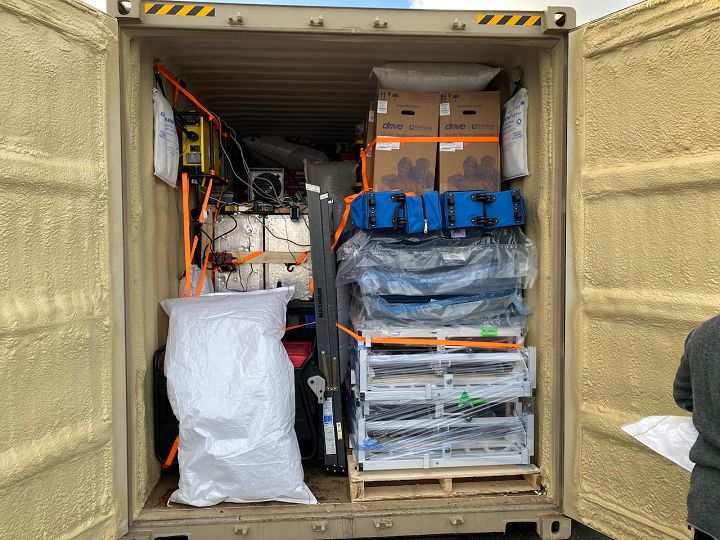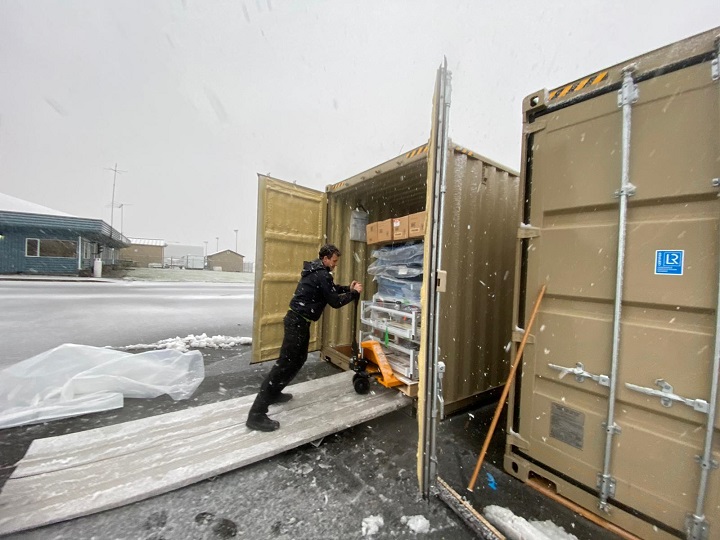With the recent blockage of the Suez Canal, people around the world have been talking about shipping containers, a topic most of us don’t typically spend much time thinking about.
But a small team of people from a wide variety of backgrounds within Health Emergency Management BC (HEMBC) have been focused on shipping containers for close to a year now – experimenting at length around a challenge they found both daunting and exciting.
The challenge? Could they somehow pack a portable care unit into a shipping container to be deployed into a temporary space in a way that would help support BC health authorities in the event of a health care emergency like a large COVID-19 surge or an unexpected disaster such as a wildfire or flood?
And from this was born the Deployable Alternate Care Sites (DACS).
“This project started out as a casual conversation between David (Thanh) and I while involved in the Vancouver Convention Centre alternate care site, trying to figure out if we could shoehorn a mobile 30 – 40 bed medical unit into a container to be deployable elsewhere,” says Landon James, clinical operations manager for HEMBC Provincial Operations team. “From there, it became a bit of an obsession, and we definitely packed and unpacked our first container 10 – 15 times.”
Following a process of successive rounds of planning and trialing the set up – learning something from each round of experimentation – the team slowly whittled down what was essential and what wasn’t. In some cases, they even had to customize items to enable them to fit into the DACS container.

Turns out, with some solid planning, creative packing and dedicated repacking, a committed team can get a huge amount of medical supplies, patient beds and various other logistical and clinical support equipment into a 40-foot box that typically would only fit the contents of your average two- to three-bedroom apartment.
The result is British Columbia now has four DACS housed in health authorities across the province, ready for a quick deployment if necessary and designed to save time and increase readiness of resources in the event of a disaster like a flood or wildfire or a health care emergency. These can range from hospital evacuations during wildfires to temporary care sites during the pandemic.
“From the 40 beds and over-bed tables, to a defibrillator, IV pumps, ultrasound unit and 10 oxygen concentrators, we’ve tried to include it all,” David Thanh, facility maintenance operations support manager with HEMBC’s Provincial Operations team explains with a chuckle. “A big reason we’ve been so successful is because the people on this DACS team have such diverse experience throughout their careers.”
One of those DACS team members with years of “non-traditional” experiences is Jo-Ann Hnatiuk, a clinical nurse educator and clinical lead of Trauma Services BC as well as a Canadian Armed Forces reservist. After deploying in Afghanistan, Guatemala, Haiti and the Dominican Republic she knows first-hand the huge value of a self-contained, well-equipped care setting like the DACS and how it can pay off, particularly in dire times.
“I’m so proud of what the team has pulled together with this,” she says. “I don’t think any other province has done anything as extensive as this.
“While I hope we never have to use it, these DACS containers will be a huge benefit for any kind of situation whether it’s wildfire season or recovery from an earthquake or any other type of disaster.”
The stages of planning, packing, and repacking took place at a site in Abbotsford graciously donated to HEMBC by the BC Wildfire Service during their ‘down’ season where there was plenty of space to both store the materials as well as spread them out to figure out how to fit them together to maximize what made it into the 76 cubic metre space, four times over!

“There’s a very specific way of packing and unpacking the DACS,” says David. “When it’s done properly, there’s very little space left to close the door of the container.”
At their Abbotsford assembly site, the team experienced snow on several occasions while working through the packing/repacking work, bringing a real-world air to the exercise.
The million-dollar question everyone wants to ask David and Landon?
Each DACS holds:
- 40 patient beds, with hand crank height adjustment and elevating back/foot rests, IV poles and attachable patient tables
- medical equipment and supplies for up to 72 hours
- medical assessment equipment
- standard and advanced resuscitation clinical equipment
- patient supports and transfer
- clinical supplies and PPE
- facility equipment (i.e. generator, electrical distribution system, mobile internet, tools)
John Lavery, executive director, HEMBC sees the DACS team and the four containers they’ve produced as the product of a strong, collaborative effort.
“The work this team has done in such a short span of time to pull these together is remarkable,” he says. “I’m confident the team’s work will support the health system to become more resilient during emergencies.”
For some project contributors, emergency management was new and brought some interesting learning experiences as they ran to keep up with the pace of the project. PHSA Buyer Michelle Nono was one of the newcomers, finding herself swept up in the urgency of the project and the extreme challenge of getting crucial items in the midst of a pandemic.
“The project was a challenge for sure but I’ve loved working with this team,” says Michelle. “Everyone was great to work with, despite the pressure at times, and I’m glad we were able to deliver on time and on budget.”
With the four DACS containers now in place in locations across the province, the team’s logical next steps are to conduct an exercise to familiarize health authority staff with the units and test the overall effectiveness of the system. This kind of exercise is important to ensuring that nothing’s been overlooked along the way.
